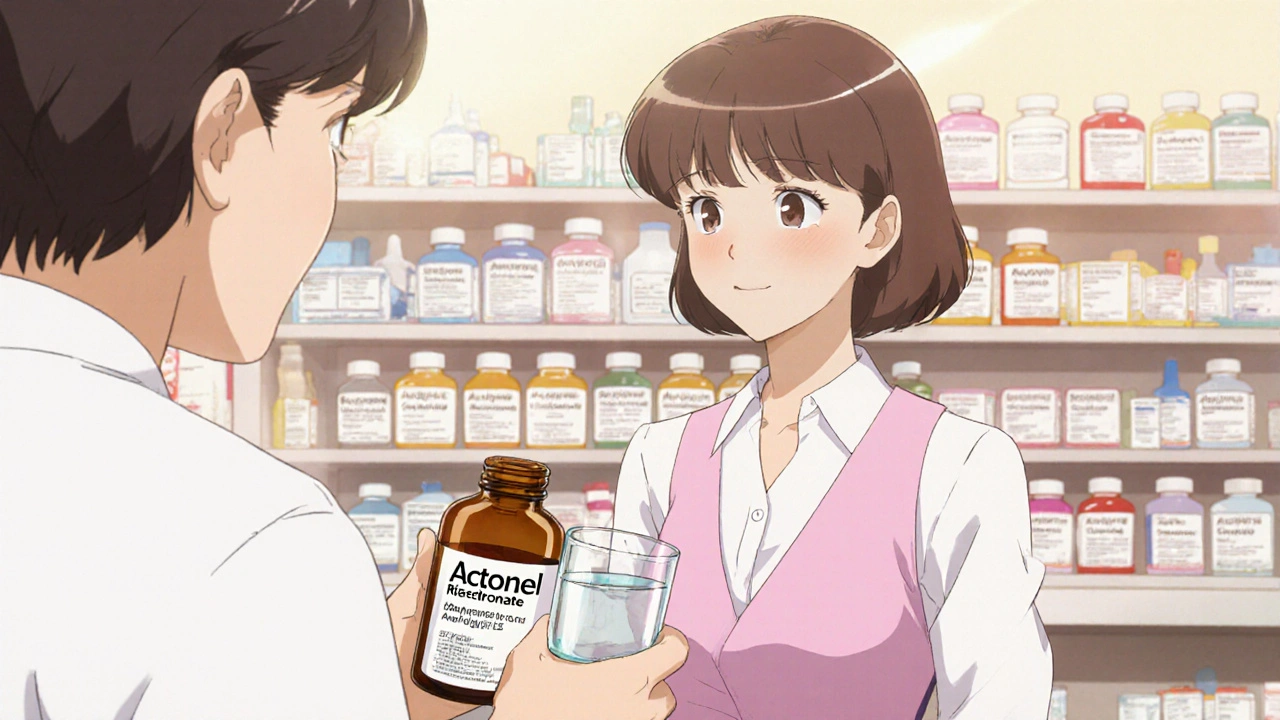Osteoporosis Drug Comparison Tool
Select your priorities
Recommended Options
Based on your preferences, the best options for you are:
Quick Takeaways
- Actonel (Risedronate) is a weekly oral bisphosphonate that works well for many post‑menopausal women but needs strict dosing rules.
- Alendronate offers daily or weekly dosing and is the most prescribed bisphosphonate in the UK.
- Ibandronate is convenient as a monthly tablet or quarterly IV infusion, reducing stomach irritation.
- Zoledronic acid is a once‑yearly IV dose, ideal for people who forget pills.
- Denosumab, Teriparatide and Romosozumab are non‑bisphosphonate options that address patients who can’t tolerate bisphosphonates.
What Is Actonel (Risedronate)?
Actonel (Risedronate) is a nitrogen‑containing bisphosphonate approved for the prevention and treatment of osteoporosis in post‑menopausal women and men at high fracture risk. It binds to bone mineral and inhibits osteoclast‑mediated bone resorption, helping to maintain or increase bone mineral density (BMD). The drug is taken orally once a week with a full glass of water, on an empty stomach, and you must stay upright for at least 30 minutes to avoid esophageal irritation.
How Actonel Works and Who Benefits
Risedronate’s chemical structure mimics pyrophosphate, a natural regulator of bone turnover. By attaching to hydroxyapatite crystals, it selectively targets areas of active bone remodeling. Osteoclasts that try to chew on these crystals become less effective, reducing bone loss.
Typical candidates include:
- Post‑menopausal women with a T‑score ≤ ‑2.5.
- Men over 50 with secondary osteoporosis.
- Patients who have already suffered a vertebral or hip fracture.
Clinical trials (e.g., the ACTIVE study) showed a 40‑45 % reduction in new vertebral fractures after three years of weekly 35 mg dosing.
Key Benefits of Actonel
- Once‑weekly dosing improves adherence compared with daily bisphosphonates.
- Proven efficacy in raising lumbar spine and total hip BMD.
- Generally well‑tolerated when dosing instructions are followed.

Common Side Effects and Safety Concerns
Most side effects are mild and gastrointestinal:
- Transient nausea or abdominal pain.
- Esophageal irritation if you lie down too soon after the dose.
Rare but serious risks include atypical femoral fractures and osteonecrosis of the jaw (ONJ), especially with long‑term use (> 5 years). The National Institute for Health and Care Excellence (NICE) advises a “drug holiday” after 3‑5 years for low‑risk patients.
Alternative Osteoporosis Medications
If the weekly routine or side‑effect profile of Actonel isn’t a good fit, several alternatives exist. Below is a quick snapshot of the most common options.
Alendronate
Alendronate is another bisphosphonate, taken daily (10 mg) or weekly (70 mg). It shares the same mechanism as Risedronate but offers a cheaper generic version in the UK.
Ibandronate
Ibandronate can be taken as a monthly tablet (150 mg) or a quarterly IV infusion (3 mg). The less frequent dosing reduces gastrointestinal complaints.
Zoledronic Acid
Zoledronic acid is given as a 5 mg IV infusion once a year. It’s popular for patients who struggle with oral tablets, though the infusion can cause transient flu‑like symptoms.
Denosumab
Denosumab is a monoclonal antibody administered subcutaneously every six months (60 mg). It works by inhibiting RANK‑L, a protein that drives osteoclast formation. Denosumab shows rapid BMD gains but requires continuous treatment-stopping it can lead to a rebound increase in bone turnover.
Teriparatide
Teriparatide is a recombinant form of parathyroid hormone given as a daily 20 µg injection. It stimulates new bone formation, making it a good choice for severe osteoporosis or patients with multiple fractures.
Romosozumab
Romosozumab is a newer sclerostin‑inhibiting antibody, administered monthly for 12 months. It both builds bone and reduces resorption, delivering some of the highest BMD gains seen to date.
Comparison Table: Actonel vs Main Alternatives
| Drug | Class | Dosing Frequency | Route | Typical Yearly Cost (GBP) | Key Advantages | Major Safety Concerns |
|---|---|---|---|---|---|---|
| Actonel (Risedronate) | Bisphosphonate | Weekly (35 mg) | Oral | ~£80 | Proven fracture reduction, convenient weekly schedule | GI irritation, rare ONJ, atypical femur fracture |
| Alendronate | Bisphosphonate | Daily (10 mg) or weekly (70 mg) | Oral | ~£60 | Well‑studied, generic option | Similar GI profile, rare ONJ |
| Ibandronate | Bisphosphonate | Monthly tablet or quarterly IV | Oral or IV | ~£100 (tablet) / £400 (IV) | Less frequent dosing, lower GI upset | Potential renal considerations with IV |
| Zoledronic acid | Bisphosphonate | Yearly | IV | ~£350 | Once‑yearly, high adherence | Flu‑like reaction, renal function monitoring |
| Denosumab | RANK‑L inhibitor | Every 6 months | Subcutaneous | ~£1,200 | Rapid BMD rise, works in CKD patients | Infection risk, rebound fractures if stopped |
| Teriparatide | PTH analog | Daily injection | Subcutaneous | ~£3,000 (24‑month course) | Stimulates new bone, good for severe cases | Potential hypercalcemia, cost |
| Romosozumab | Sclerostin inhibitor | Monthly (12 months) | Subcutaneous | ~£4,500 | Both builds and preserves bone, highest BMD gains | Cardiovascular warnings, expensive |
When to Choose Actin el Over the Rest
If you value a simple weekly pill, have a relatively intact gastrointestinal tract, and prefer a medication covered by the NHS for a modest price, Actonel is a solid first‑line pick. It shines for patients who:
- Are newly diagnosed with osteoporosis and have a BMD T‑score between ‑2.5 and ‑3.0.
- Can commit to the 30‑minute upright rule after dosing.
- Do not have severe renal impairment (eGFR < 30 ml/min).
For people who have struggled with esophageal irritation, missed doses, or who need a faster BMD response, one of the non‑bisphosphonate options (Denosumab, Teriparatide, Romosozumab) may be a better fit.
Practical Checklist Before Starting Actonel
- Confirm your diagnosis with a Bone Mineral Density scan and FRAX risk estimate.
- Review current medications for calcium or antacid interactions.
- Discuss any history of esophageal disease with your GP or specialist.
- Plan a 30‑minute window on a day without meals to take the tablet.
- Schedule a follow‑up DXA scan in 12‑18 months to assess response.
Frequently Asked Questions
Can I take Actonel with calcium supplements?
Yes, but keep at least a two‑hour gap. Calcium can bind to the tablet and reduce absorption, so take calcium after the 30‑minute upright period.
What if I forget a weekly dose?
Skip the missed dose and resume your regular schedule. Do not double‑dose, because excess can raise the risk of stomach irritation.
Is Actonel safe for men?
Yes. The drug is approved for men at high fracture risk, and studies show similar BMD improvements as in women.
How does Actonel compare to Denosumab for hip fracture prevention?
Denosumab generally yields a larger reduction in hip fracture risk within the first two years, but it’s injectable and more costly. Actonel offers a modest hip fracture benefit with the convenience of a pill.
When should I consider a drug holiday?
NICE suggests a 1‑2‑year pause after 3‑5 years of therapy for patients with low to moderate fracture risk, provided BMD remains stable.
Bottom Line
Actonel (Risedronate) remains a reliable, cost‑effective choice for many with osteoporosis, especially when adherence to a weekly oral schedule is realistic. Yet the market now includes several powerful alternatives that address specific drawbacks-GI intolerance, dosing frequency, rapid BMD gains, or renal concerns. By weighing efficacy, route, cost, and safety, you and your healthcare provider can pick the drug that best fits your lifestyle and risk profile.

Wade Grindle
October 22, 2025 AT 21:31The weekly dosing schedule of Actonel does simplify adherence compared to daily bisphosphonates, and the oral route avoids the clinic visits required for intravenous therapies.
Joe Waldron
October 23, 2025 AT 22:31Indeed, Actonel’s 35 mg tablet-taken with a full glass of water, on an empty stomach, and followed by a mandatory 30‑minute upright period-offers a convenient regimen, yet it also demands strict compliance, otherwise gastrointestinal irritation may ensue, and the risk of esophageal ulceration can increase sharply, especially if patients lie down too soon after ingestion!
Sameer Khan
October 24, 2025 AT 23:31The pharmacodynamic profile of risedronate hinges upon its high affinity for hydroxyapatite crystals, thereby ensuring targeted osteoclast inhibition at sites of active remodeling. By mimicking endogenous pyrophosphate, the molecule interferes with the mevalonate pathway, culminating in reduced prenylation of small GTPases essential for osteoclast function. Clinical trial data, notably the ACTIVE and VERT-FA studies, have demonstrated a relative risk reduction of approximately 40 % for vertebral fractures over a three‑year horizon. Moreover, subgroup analyses reveal consistent efficacy across both post‑menopausal women and men over fifty with secondary osteoporosis, underscoring its versatility. The dosing convenience of a once‑weekly oral formulation mitigates the adherence challenges commonly associated with daily bisphosphonates, as reflected in medication possession ratio metrics. Nevertheless, the gastrointestinal safety profile necessitates vigilant patient education, given the propensity for esophageal mucosal irritation in the absence of proper administration techniques. Renal clearance considerations are modest for risedronate, yet clinicians should exercise caution in patients with estimated glomerular filtration rates below 30 mL/min/1.73 m². From a health‑economic perspective, the annual cost of approximately £80 positions Actonel as a cost‑effective first‑line option within the UK National Health Service formulary. Comparative effectiveness assessments indicate that while denosumab may afford a more rapid increase in bone mineral density, its biannual subcutaneous administration and higher price point render it less suitable for patients prioritizing oral therapy. Conversely, agents such as ibandronate or zoledronic acid provide alternative dosing intervals-monthly or yearly, respectively-yet each carries distinct adverse event spectra, including transient influenza‑like reactions for the latter. The concept of a “drug holiday” after three to five years of bisphosphonate exposure, as advocated by NICE, reflects emerging consensus on mitigating rare complications such as atypical femoral fractures and osteonecrosis of the jaw. Importantly, the decision to initiate a holiday must be individualized, taking into account baseline fracture risk, BMD trends, and patient preference. In practice, a structured assessment using FRAX scores and serial dual‑energy X‑ray absorptiometry can guide clinicians in timing therapy interruption and re‑initiation. Ultimately, the selection of Actonel versus alternative osteoporosis therapeutics should be grounded in a comprehensive risk‑benefit analysis that incorporates efficacy, safety, adherence potential, and socioeconomic factors. By integrating these considerations, healthcare providers can tailor a regimen that optimally preserves skeletal integrity while aligning with the patient’s lifestyle and health goals.
Vin Alls
October 26, 2025 AT 00:31Think of Actonel as the reliable workhorse in the osteoporosis stable-it may not have the flash of a shiny sports car like romosozumab, but it gets the job done week after week, letting you sip your coffee without a daily pill parade.
Tiffany Davis
October 27, 2025 AT 01:31I appreciate the analogy; indeed, a steady “workhorse” can be more reassuring for patients who prefer predictability over novelty.
Don Goodman-Wilson
October 28, 2025 AT 02:31Wow, another pill to remember-just what America needed.
Bret Toadabush
October 29, 2025 AT 03:31Look, the pharmaco‑industry loves to push these “weekly pills” on us, cuz they want us glued to their profit machines, and the gov’t barely mentions the hidden calcium‑binding traps that can mess up your bones-definately something they don’t want you to know.
Iris Joy
October 30, 2025 AT 04:31Sticking to the right schedule can feel tricky, but setting a reminder on your phone and keeping a water bottle handy makes the 30‑minute upright rule much easier-think of it as a short power‑up for your bones!